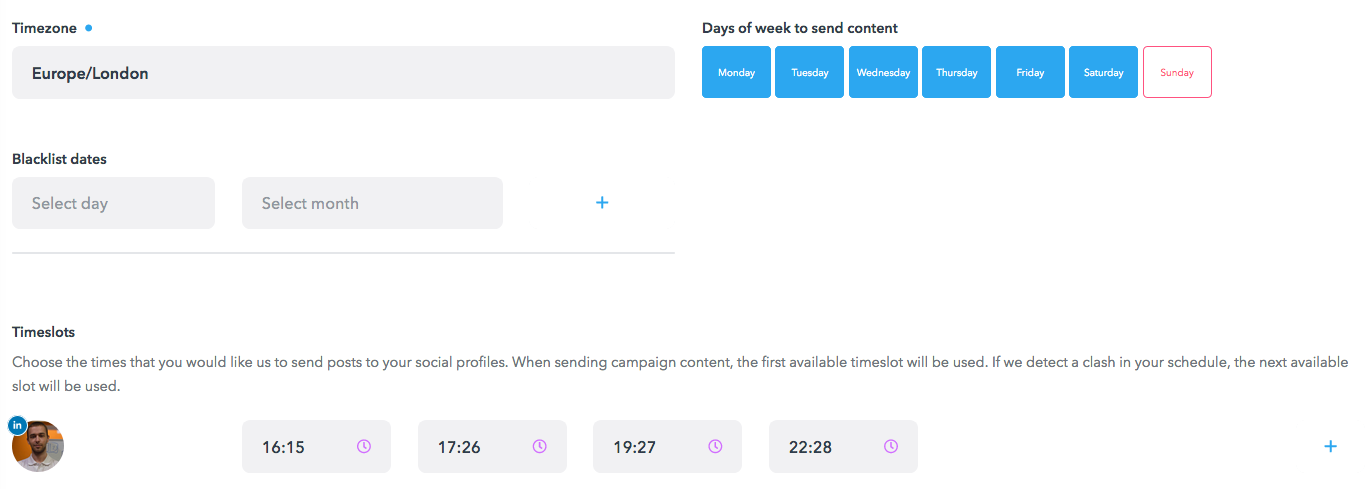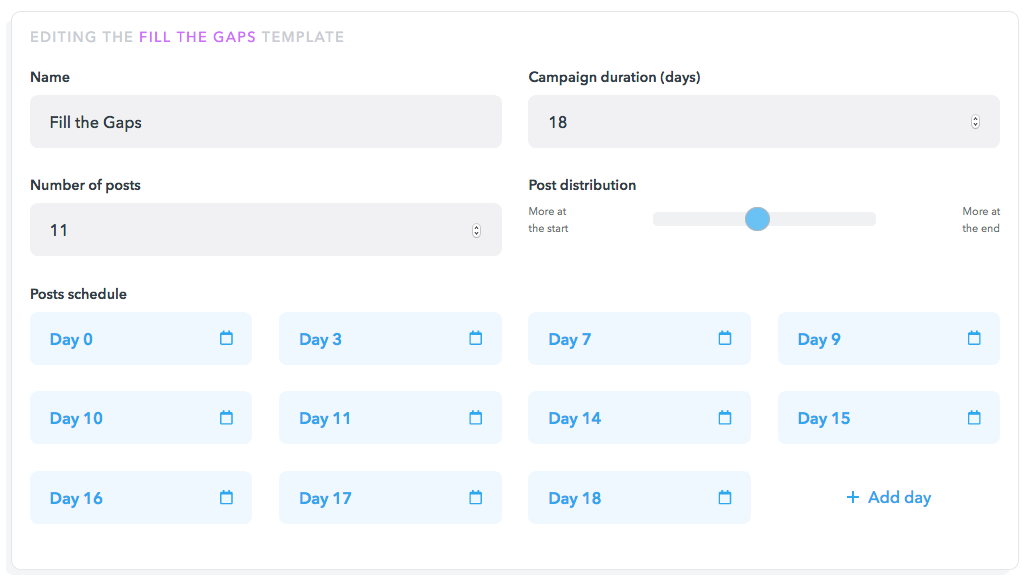Table of Contents
Scheduler
The Scheduler system controls how posts from active campaigns are distributed across your calendar.
How your posts are scheduled depends on:
- How you set up your date and time settings.
- The start and end dates of your campaigns.
- The post distribution configured through schedule templates.
TL;DR
The 5 campaign experiment
We will launch 5 campaigns and cover all aspects of the Scheduler system, one campaign at a time, and see how our schedule adapts and changes through the process.
Setup
To keep it as simple as possible, say today is Monday and our campaigns use the default schedule template:

In date and time settings, we would like to post content on weekdays, and send no more than two posts per day:


At this stage, our calendar is empty and all time slots are free. Alright, now let's launch some campaigns.
1st - Single campaign delay
Our first campaign uses the default schedule template. While reviewing it, on step 3, we set the start date to today and leave the end date empty.
Here is how our 1st campaign got scheduled in the first three weeks:

Day 0 post was scheduled for today.
Day 3 post got scheduled three days later, on Thursday.
Day 7 post was scheduled 7 days into the future, to next Monday.
Day 14 was scheduled two weeks from now.
Based on this, we can draw a conclusion -
2nd - Filling the time slots
Our 2nd campaign uses the same schedule template and also starts on Monday. Here is how it looks after it was scheduled:

We have now filled in the two time slots we allocated to our LinkedIn account. Onto the next campaign.
3rd - Time slot delay
Just like the first two campaigns, our 3rd campaign uses the default schedule template and starts on Monday - here is how it got scheduled:

Day 0 got scheduled on Tuesday even though we instructed it to start on Monday. All other days from our 3rd campaign also got delayed by one day. This happened because Monday already has two posts and we have two time slots available.
4th - Minimum delay
Our 4th campaign is a bit different - it will start on Wednesday (green rectangle) and we want to end a campaign in two weeks (red rectangle).

Day 0 post got scheduled for Wednesday as expected since there were enough time slots.
Day 3 on the other hand got delayed until Tuesday, which is more than the expected offset of 3 days. Since we disabled weekend posting in settings, our Day 3 post couldn't find a free time slot 3 days in the future because it's a Saturday. It also couldn't find a free time slot on Monday since both are occupied - it found a free time slot on Tuesday and claimed it.
If we take a look at our Day 7 post - it ended up getting scheduled 13 days after the start date. This happened because of the minimum campaign delay.
If we return to the calendar, we see that our Day 7 post should have been scheduled for next Wednesday, but the minimum campaign delay caused it to be pushed for three days. Our post couldn't find a slot on Saturday or Sunday, Monday is full of posts - so it settled on a Tuesday, almost two weeks from now.
Since our end date is just a day after our Day 7 got scheduled, Day 14 and all other days within our 4th campaign will not be posted.
4 3/4 - Auto-rescheduling
Before we launch our 5th campaign, let's edit our date and time settings. Instead of two posts per day, let's set 4 time slots and enable posting on Saturday:

If we go to our calendar now, we'll see that our 4 active campaigns got automatically rescheduled.
Let's briefly go through each campaign to see what happened here:

The first two campaigns are exactly where they were when we launched them - they had no conflicts with the new date and time settings, so there was no need to reschedule them.
The 3rd campaign's Day 0 stayed where it was, but other days were rescheduled, since now there are enough time slots to fit them in days they were supposed to go out.
Our 4th campaign got modified a bit - its Day 3 post could now fit on Saturday and the minimum campaign delay didn't kick in so Day 7 got scheduled exactly a week after the first post. Our Day14 post is still missing, because we configured the end date exactly 14 days after the start date - no content from a campaign can be sent on it's defined end date.
5th - Filling in the gaps
Now, onto our fifth campaign.
This one is special - we want to fill in all the gaps we have in our current calendar, because we would like to send at least one post per day. I wrote a neat post that has a ~3week shelf life to neatly fill in the gaps we have in our calendar, considering our campaign starts on Tuesday:

To achieve this, we should first create a custom schedule template. Here it is:

We regenerate our campaign to apply the schedule template, launch it, starting from Tuesday. Our calendar now looks like this:

Notice how each post got scheduled exactly where it was supposed to.
Adding another social profile
Now that we're happy with our schedule, let's add another social profile, to see what happens.
After adding a Facebook page, we should go to the Date and Time settings to confirm the time slots are the way we want them to be - no more than 4 posts per day:

If we go to our calendar, here is what we can see:

Each of the existing campaigns were automatically expanded with posts for Facebook.
Further Reading
